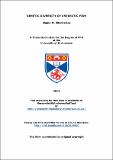Files in this item
Genetic diversity of Antarctic fish
Item metadata
| dc.contributor.advisor | Rogers, Alex, 1968- | |
| dc.contributor.advisor | Clark, Melody | |
| dc.contributor.advisor | Brierley, Andrew | |
| dc.contributor.author | Fitzcharles, Elaine M. | |
| dc.coverage.spatial | xi, 185 p. | en_US |
| dc.date.accessioned | 2015-06-24T09:15:27Z | |
| dc.date.available | 2015-06-24T09:15:27Z | |
| dc.date.issued | 2015-06-24 | |
| dc.identifier.uri | https://hdl.handle.net/10023/6860 | |
| dc.description.abstract | Correct species identification is fundamental to all areas of biology, but particularly the policy related areas of conservation and fisheries management. To enable guidelines to be developed for environmental management and conservation, such identifications need links to studies of the evolutionary history, biological factors and environmental influences driving species divergence and population dynamics for the target species. This study concerns two genera of gadiform fish, Muraenolepis and Macrourus, found in southern temperate and Antarctic waters, with a single species, Macrourus berglax, present in the North Atlantic. With similar distribution patterns to toothfish species, Dissostichus eleginoides and D. mawsoni, they are a major food source and by-catch of the toothfish fishery. Both are slow growing and long lived, with different evolutionary histories, life expectancies and strategies for reproduction. For both genera, the accuracy of morphological keys, number of described species and their distribution is under debate. This study has identified specimens to species level using both morphological and genetic techniques, redefining the range for morphological features and taxonomic keys. For Muraenolepis, this has clarified confusion over Mu. marmoratus and Mu. microps being a single species, confirmed some mis-identification from sexual dimorphism and provided genetic evidence for the recently described species Mu. evseenkoi. For Macrourus, this work has identified a new species, now named Ma. caml, and found that Ma. holotrachys and Ma. berglax are genetically identical, raising the question of bipolar distribution or recent divergence. The low level of genetic variation within both species suggests a recent evolution and expansion into Antarctic waters. Similar geographic species limits imply common processes influencing divergence, with the oceanographic fronts as potential barriers. Further investigation of niche overlap and fine scale population structure are required to fully understand the processes driving speciation and provide the underlying data required for fisheries management. | en_US |
| dc.language.iso | en | en_US |
| dc.publisher | University of St Andrews | |
| dc.subject | Antarctica | en_US |
| dc.subject | Population genetics | en_US |
| dc.subject | Fisheries | en_US |
| dc.subject | Integrative taxonomy | en_US |
| dc.subject | DNA barcoding | en_US |
| dc.subject | Biodiversity | en_US |
| dc.subject | Gadiformes | en_US |
| dc.subject.lcc | QL637.2F5 | |
| dc.subject.lcsh | Fishes--Antarctica | en_US |
| dc.subject.lcsh | Population genetics | en_US |
| dc.subject.lcsh | Biodiversity--Antarctica | en_US |
| dc.title | Genetic diversity of Antarctic fish | en_US |
| dc.type | Thesis | en_US |
| dc.contributor.sponsor | British Antarctic Survey | en_US |
| dc.type.qualificationlevel | Doctoral | en_US |
| dc.type.qualificationname | PhD Doctor of Philosophy | en_US |
| dc.publisher.institution | The University of St Andrews | en_US |
| dc.publisher.department | British Antarctic Survey | en_US |
This item appears in the following Collection(s)
Items in the St Andrews Research Repository are protected by copyright, with all rights reserved, unless otherwise indicated.

